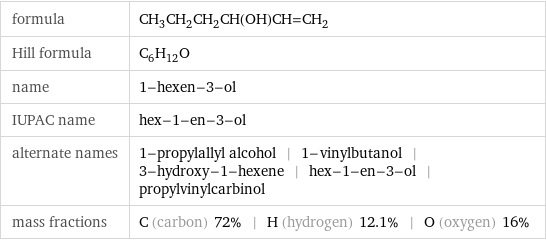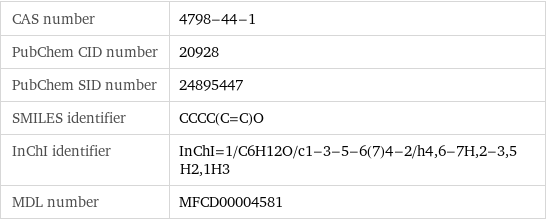Input interpretation

1-hexen-3-ol
Chemical names and formulas

formula | CH_3CH_2CH_2CH(OH)CH=CH_2 Hill formula | C_6H_12O name | 1-hexen-3-ol IUPAC name | hex-1-en-3-ol alternate names | 1-propylallyl alcohol | 1-vinylbutanol | 3-hydroxy-1-hexene | hex-1-en-3-ol | propylvinylcarbinol mass fractions | C (carbon) 72% | H (hydrogen) 12.1% | O (oxygen) 16%
Lewis structure

Draw the Lewis structure of 1-hexen-3-ol. Start by drawing the overall structure of the molecule, ignoring potential double and triple bonds: Count the total valence electrons of the carbon (n_C, val = 4), hydrogen (n_H, val = 1), and oxygen (n_O, val = 6) atoms: 6 n_C, val + 12 n_H, val + n_O, val = 42 Calculate the number of electrons needed to completely fill the valence shells for carbon (n_C, full = 8), hydrogen (n_H, full = 2), and oxygen (n_O, full = 8): 6 n_C, full + 12 n_H, full + n_O, full = 80 Subtracting these two numbers shows that 80 - 42 = 38 bonding electrons are needed. Each bond has two electrons, so in addition to the 18 bonds already present in the diagram add 1 bond. To minimize formal charge carbon wants 4 bonds. Identify the atoms that want additional bonds and the number of electrons remaining on each atom: Fill in the 1 bond by pairing electrons between adjacent highlighted atoms: Answer: | |
3D structure

3D structure
Basic properties

molar mass | 100.16 g/mol phase | liquid (at STP) melting point | -72 °C boiling point | 134.5 °C density | 0.834 g/cm^3 solubility in water | slightly soluble
Units

Liquid properties (at STP)

density | 0.834 g/cm^3 refractive index | 1.428
Units

Thermodynamic properties

critical temperature | 572 K critical pressure | 3.67 MPa (at STP)
Chemical identifiers

CAS number | 4798-44-1 PubChem CID number | 20928 PubChem SID number | 24895447 SMILES identifier | CCCC(C=C)O InChI identifier | InChI=1/C6H12O/c1-3-5-6(7)4-2/h4, 6-7H, 2-3, 5H2, 1H3 MDL number | MFCD00004581
Safety properties

flash point | 35 °C

DOT hazard class | 3 DOT numbers | 1987